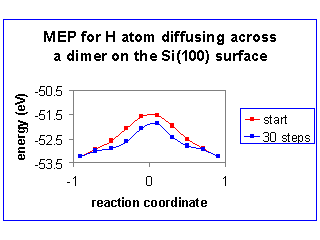NCSA Nanotechnology InitiativeTesting transition state searching algorithms for use with plane-wave DFT codesInformation on activation barriers is of central importance for estimating rates, providing an understanding of mechanisms and evaluating possible rate-enhancing modifications. Transition state optimization methods employed in non-periodic ab initio codes (such as Gaussian 98, Jaguar, and Spartan generally use analytic first derivatives together with analytical or good numerical estimates of the Hessian. Most theoretical work on periodic systems (surfaces and bulk) is currently carried out using plane-wave methods for which accurate evaluation of the Hessian is difficult due to the use of grids. Two promising non-Hessian based transition state optimization algorithms are the Ridge algorithm1,2 (from Carter's group at UCLA) and the Nudged Elastic Band (NEB) algorithm 3,4 (from Jónsson's group at U. of Washington). We are testing these algorithms as implemented in plane wave codes for locating transition states for various surface rearrangement processes. Below we summarize the main features of the NEB algorithm, which has been used in most of our studies to date. The NEB algorithm, which is an improvement of the previously used Elastic Band algorithm, only requires evaluation of the potential energy and its first derivatives. It converges to the minimum energy path (MEP) in a well-defined limit. The transition state corresponds to the highest energy point along the MEP. The NEB algorithm is highly parallelizable since it involves multiple constrained minimizations that can be carried out simultaneously and that do not require much interprocessor communication. The computational effort grows slowly with system size. Outline of the Elastic Band Method
Shortcomings
Outline of the Nudged Elastic Band MethodThe NEB algorithm addresses the shortcomings of the simple elastic band methods by setting the spring force in directions perpendicular to the the path equal to zero (this solves the "corner cutting" problem) and by setting the true forces along the path to zero (this prevents the images from sliding towards the endpoints and improves the density of images near the transition state). The unit vector
Minimize F with respect to 3N(P-1) coordinates. What the Jordan Group is Doing With NEBInitial tests of NEB interfaced with the VASP
plane-wave DFT code are encouraging.
The figure below depicts the results for a NEB optimization of the reaction path for an H atom
hopping between the Si atoms of an Si-Si dimer on the Si(100)-2x1 surface. The calculated barrier - 1.50eV -
is identical to that found by minimization with symmetry imposed.
We have recently employed the NEB algorithm to map out the MEP for 3x1 ---> 2x1
rearrangements on the Si(100) surface.
The reaction pathway for the rearrangements is very complex.
In the future, we plan to:
1I. V. Ionova and E. A. Carter, J. Chem. Phys., 98, 6377 (1993). 2I. V. Ionova and E. A. Carter, "DIIS-Induced Acceleration of the Ridge Method for Finding Transition States," J. Chem. Phys., 102, 1251 (1995). 3G. Mills, H. Jónsson and G. K. Schenter, Surface Science, 324, 305 (1995). 4H. Jónsson, G. Mills, K. W. Jacobsen, `Nudged Elastic Band Method for Finding Minimum Energy Paths of Transitions', in `Classical and Quantum Dynamics in Condensed Phase Simulations', ed. B. J. Berne, G. Ciccotti and D. F. Coker (World Scientific, 1998), page 385. 5T.-C. Shen, J.A. Steckel, and K.D. Jordan, "Electron-Stimulated Bond Rearrangements on the H/Si(100)-3x1 surface", Surf. Sci., 446, 211-218 (2000). |
Dept. of Chemistry, University of Pittsburgh,
219 Parkman Avenue, Pittsburgh, PA 15260
Phone: (412) 624-8690 FAX: (412) 624-8611 email: jordan at pitt.edu
This page last updated:

